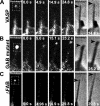Ena/VASP proteins have an anti-capping independent function in filopodia formation
- PMID: 17475772
- PMCID: PMC1924831
- DOI: 10.1091/mbc.e06-11-0990
Ena/VASP proteins have an anti-capping independent function in filopodia formation
Abstract
Filopodia have been implicated in a number of diverse cellular processes including growth-cone path finding, wound healing, and metastasis. The Ena/VASP family of proteins has emerged as key to filopodia formation but the exact mechanism for how they function has yet to be fully elucidated. Using cell spreading as a model system in combination with small interfering RNA depletion of Capping Protein, we determined that Ena/VASP proteins have a role beyond anticapping activity in filopodia formation. Analysis of mutant Ena/VASP proteins demonstrated that the entire EVH2 domain was the minimal domain required for filopodia formation. Fluorescent recovery after photobleaching data indicate that Ena/VASP proteins rapidly exchange at the leading edge of lamellipodia, whereas virtually no exchange occurred at filopodial tips. Mutation of the G-actin-binding motif (GAB) partially compromised stabilization of Ena/VASP at filopodia tips. These observations led us to propose a model where the EVH2 domain of Ena/VASP induces and maintains clustering of the barbed ends of actin filaments, which putatively corresponds to a transition from lamellipodial to filopodial localization. Furthermore, the EVH1 domain, together with the GAB motif in the EVH2 domain, helps to maintain Ena/VASP at the growing barbed ends.
Figures









References
-
- Bachmann C., Fischer L., Walter U., Reinhard M. The EVH2 domain of the vasodilator-stimulated phosphoprotein mediates tetramerization, F-actin binding, and actin bundle formation. J. Biol. Chem. 1999;274:23549–23557. - PubMed
-
- Ballestrem C., Wehrle-Haller B., Imhof B. A. Actin dynamics in living mammalian cells. J. Cell. Sci. 1998;111(Pt 12):1649–1658. - PubMed
Publication types
MeSH terms
Substances
Grants and funding
LinkOut - more resources
Full Text Sources
Molecular Biology Databases

